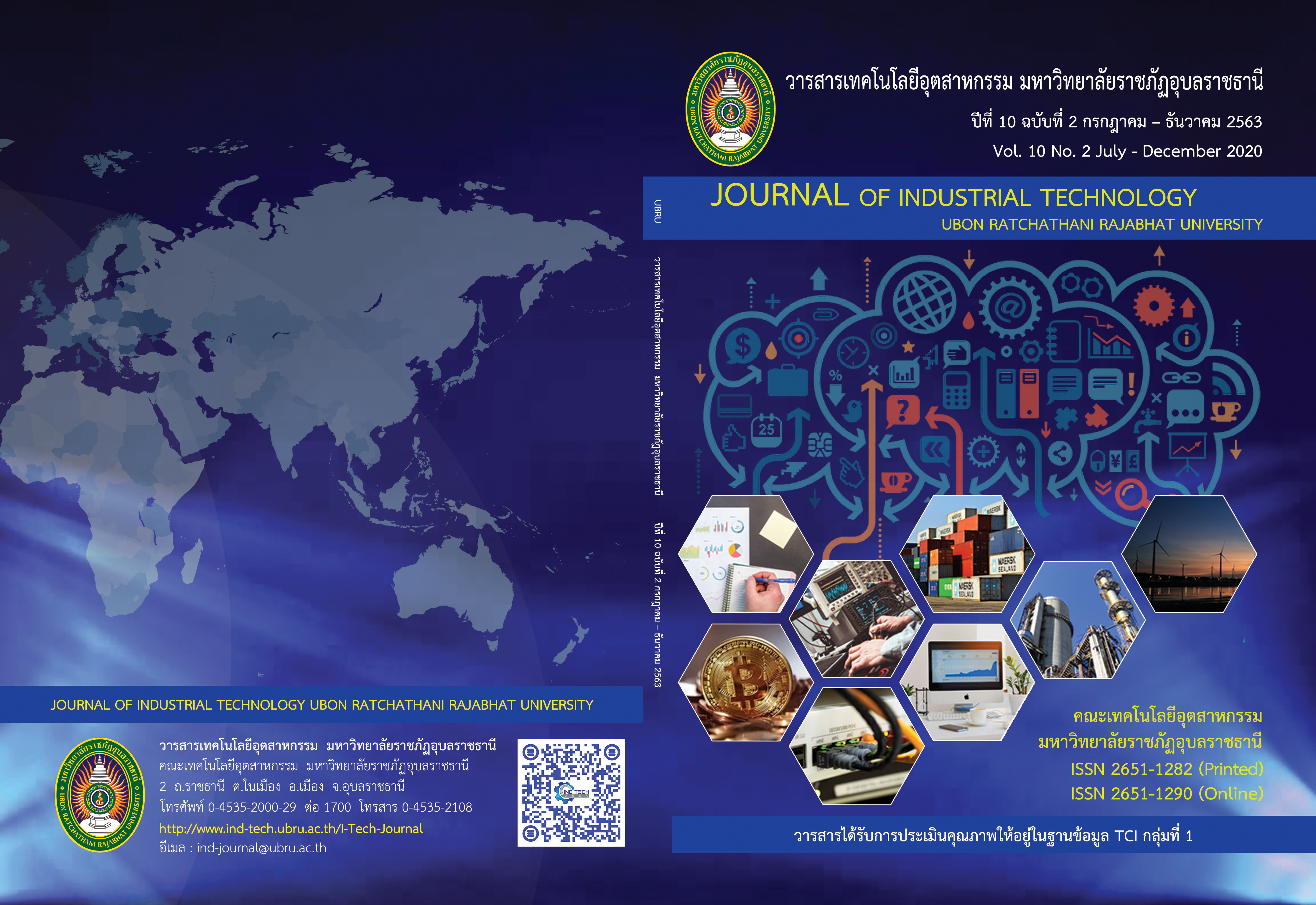การสังเคราะห์ไฮดรอกซีอะพาไทต์จากกระดูกวัวสำหรับการลดฟลูออไรด์ในน้ำ
Main Article Content
บทคัดย่อ
ประเทศไทยมีปริมาณฟลูออไรด์ในน้ำบาดาลสูงในหลายพื้นที่และจะเป็นอันตรายหากนำน้ำดังกล่าวมาอุปโภคบริโภค ปัจจุบันมีการศึกษาวัสดุสำหรับการลดปริมาณฟลูออไรด์ในน้ำจากวัสดุหลายชนิด ในการศึกษาครั้งนี้ได้ทำการศึกษาการลดปริมาณฟลูออไรด์ในสารละลายน้ำสังเคราะห์จากวัสดุแคลเซียมฟอสเฟสชนิดไฮดรอกซีอะพาไทต์จากกระดูกวัว เริ่มจากทำการศึกษาการสังเคราะห์ไฮดรอกซีอะพาไทต์จากกระดูกวัวด้วยวิธีการทางความร้อนโดยศึกษาการเปลี่ยนแปลงโครงสร้างผลึกและการเปลี่ยนแปลงทางกายภาพของกระดูกวัวที่ความร้อนช่วงอุณหภูมิต่าง ๆ ไฮดรอกซีอะพาไทต์ที่สังเคราะห์ได้จากกระดูกวัวถูกนำไปศึกษาการวิเคราะห์ค่า pH ที่มีประจุที่ผิวเป็นศูนย์ (Point of zero charge, pHpzc) เพื่อประเมินสภาวะการดูดซับของไฮดรอกซีอะพาไทต์ และศึกษาผลกระทบของค่า pH ต่อความสามารถและประสิทธิภาพในการดูดซับฟลูออไรด์ในน้ำด้วยวิธีการแบทซ์ (Batch experiment) กระดูกวัวที่ผ่านกระบวนการทางความร้อนที่อุณหภูมิ 1,000 องศาเซลเซียส เป็นระยะเวลา 1 ชั่วโมง เปลี่ยนแปลงโครงสร้างผลึกไปเป็นไฮดรอกซีอะพาไทต์ที่มีความเป็นผลึกสูงโดยมีขนาดอนุภาคเฉลี่ย 1 ไมโครเมตร ไฮดรอกซีอะพาไทต์จากกระดูกวัวมีค่า pH ที่ประจุที่ผิวเป็นศูนย์ (pHpzc) ที่ pH 10.5 ไฮดรอกซีอะพาไทต์จากกระดูกวัวมีความสามารถและประสิทธิภาพในการลดปริมาณฟลูออไรด์สูงสุด 1.3 มิลลิกรัม F-/กรัม และ 65% ที่ pH 6 ตามลำดับ โดยใช้ไฮดรอกซีอะพาไทต์ในการทดสอบปริมาณ 0.5 กรัม
Article Details

อนุญาตภายใต้เงื่อนไข Creative Commons Attribution-NonCommercial-NoDerivatives 4.0 International License.
บทความที่ได้รับการตีพิมพ์ในวารสารฯ ท้ังในรูปแบบของรูปเล่มและอิเล็กทรอนิกส์เป็นลิขสิทธิ์ของวารสารฯ
เอกสารอ้างอิง
Atikomrungskrit S, Arunsong S. Fluoride in groundwater sources in Thailand. Conferences Department's progress and vision of the development of mineral resources medication; 1995 January 11-13; Department of Mineral Resources meeting room. p. 645-57 (in Thai)
WHO, Chemical fact sheets: fluoride, Guidelines for drinking water quality: incorporation first addendum, third ed. Recommendation. 2006; 1: 375-7.
Hileman B. Fluoride Concerns Surfaces Once Again [internet]. 2003 [cited 2019 April 21] available from: http://fluoridealert.org/articles/nrc01/
Nithat J. Defluoridation by adsorption Process [thesis]: Thammasat University; 2008. (in Thai)
Tahaikt M, Achary I, MekouchiSahli MA, Amor Z, Taky M, Alami A, Boughrib A, Hafsi M, Elmidaoui A. Defluoridation of Moroccan ground water by electrodialysis: continuous operation. desalination. 2004; 167: 357-8.
Cohen D, Connrad HM. 65,000 GPF fluoride removal membrane system in Lakeland, California, USA. desalination. 1998; 117: 19-35.
Fawell J, Bailey K, Chilton J, Dahi E, Fewtrell L, Magara Y. Fluoride in drinking-water. London: IWA Publishing; 2006.
Ghorai S, Pant kk. Investigation on the column performance of fluoride adsorption by activated alumina in fixed-bed. Chem Eng J. 2004; 98: 165-73.
Arega R, Soni S, Sharma CS. Flouride adsorption from aqueous solution using activated carbon obtained from KOH¯ treated jamun (Syzygium cumini) seed. J Environ Eng. 2017; 5: 5608-16.
Jimenez-Reys M, Solache-Rios M. Sorption behavior of fluoride ions from aqueous solution by hydroxyapatite. J Hazard Master. 2010; 180: 297-302.
Liang W, Zhan L, Piao L, Russel C. Fluoride removal performance of glass derived hydroxyapatite. Mater. Res. Bull. 2011; 46: 205-9.
Rojas-Mayorga CK, Silvestre-Albero J, Aguayo-Villarreal IA, Mendoza-Castillo DI, Bonilla-Petriciolet A. A new synthesis route for bone chars using CO2 atmosphere and their application as fluoride adsorbents. Microp. Mesopor. Mat. 2015; 209: 38–44.
Asgari G, Dayari A, Ghasemi M, Seid-mohammadi A, Gupta VK, Agarwal S. Efficient fluoride removal by preparation, characterization of pyrolysis bone: Mixed level design experiment and Taguchi L8 orthogonal array optimization. J Mol Liq. 2019; 275: 251–64.
Mobasherpour I, Soulati Heshajin M, Kazemzadeh A, Zakeri M. Synthesis of nanocrystalline hydroxyapatite by using precipitation method. J Alloy Compd. 2007; 430: 330-3.
Shih WJ, Wang MC, Hon MH. Morphology and crystallinity of the nanosized hydroxyapatite synthesized by hydrolysis using cetyltrimethylammonium bromide (CTAB) as a surfactant. J. Cryst. Growth. 2005; 275: e2339-44.
Ozawa M, Suzuki S. Microstructural development of natural Hydroxyapatite originated from fish-bone waste through heat treatment. J Am Ceram Soc. 2002; 85: 1315-7.
Huang YC, Hsiao PC, Chai HJ. Hydroxyapatite extracted from fish scale: Effects on MG63 ostedoblast-like cells. Ceram Int. 2011; 37: 1825-31.
Sobczak A, Kida A, Kowalski Z, Wzorek Z. Evaluation of the biomedical properties of hydroxyapatite obtained from bone waste. Po. J. Chem. 2009; 11: 37-43.
Patel S, Han J, Qiu W, Gao W. Synthesis and characterization of mesoporous bone char obtained by pyrolysis of animal bone, for environmental application. J Environ Chem Eng. 2015; 3: 2368-77.
Mondal S, Mondal B, Dey A, Mukhopadhyay SS. Studies on processing and characterization of Hydroxyapatite biomaterials from different bio wastes. Journal of Minerals & Materials Characterization & Engineering. 2012; 11: 55-67.
Gao S, Cui J, Wei Z. Study on the fluoride adsorption of various apatite materials in aqueous solution. J. Fluorine Chem. 2009; 130: 1035–41.


